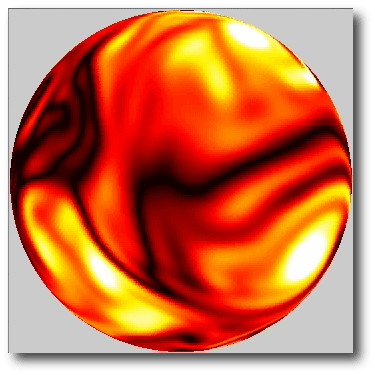
One of the systemic project’s most important goals is to reach the point where we can have genuinely realistic and aesthetically satisfying simulated images and animations of extrasolar planets. This will serve the scientific purpose of allowing us to get better comparisons with infrared observational data, and will ultimately allow us to embark on vicarious missions to the new-found worlds of our Galaxy.
In the interim, there’s a lot of coding and computing to do.
As described in this post from earlier this month, I’m advising UCSC Physics graduate student Jonathan Langton on a Ph.D. thesis geared to simulating the atmospheres of irradiated extrasolar planets. Jonathan finally graded his way through a horrific stack of lab reports and final exams, and has now been able to put full focus on the research. Progress is evident in a heavy stream of e-mails containing increasingly detailed animations.
Jonathan is using a numerical technique known as the pseudo-spectral method to do his simulations. The key idea is that the flow pattern on the surface of the simulated planetary sphere can be broken down into a superposition of Fourier modes. For example, as one moves around the planet, the longitudinal variations in the flow can be described in terms of a superposition of sinusoidal patterns. Sinusoids have analytically computable derivatives, which allow one to make a highly accurate representation of changes in the flow without resorting to a cripplingly large amount of computation.
Spectral methods have their drawbacks, however, in the form of high-frequency numerical noise. This noise was evident in the earlier simulations in the form of transient ribbed patterns within the flow. Over the past few days, Jonathan has designed an elegant filtering scheme which seems to be working very well in supressing these spurious features without killing the actual structures in the flow.

The snapshot above is from a test-calculation that implements the new filtering scheme. It’s part of an animation that simulates the development of an initially random vortical flow on the surface of a planet with the radius, mass, and rotation period of HD 209458 b. (Potential vorticity is the quantity plotted, resolution is 256×128, and the simulation runs for 5 rotational periods).

Here is a link to Jonathan’s latest (7MB) animation. It’s hot off the computer.

Looks like some crazy storms on that planet… from an artistic point of view, it would be nice to know where the terminator is in relation to all this.
Hi Andy,
I believe that the particular animation above is centered on the substellar point. In the very near future, we’ll be releasing simulations that show the whole planet, and which run at considerably higher resolution.
best,
Greg